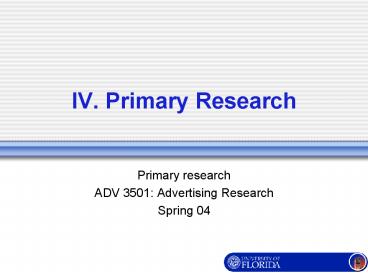IV. Primary Research PowerPoint PPT Presentation
1 / 28
Title: IV. Primary Research
1
IV. Primary Research
- Primary research
- ADV 3501 Advertising Research
- Spring 04
2
Housekeeping
- To read
- Chapters 6 and 9
- To do
- First (qualitative) proposal 2/24. Check slides
for Class 06 - If you have it ready before this date please turn
it in. - Qualitative report 3/23
- Therefore the mini-group has to be done between
March 1 and March 5 and the focus group has to be
done between March 15 and March 19. - Team leaders meeting (Secondary and qualitative
sections) 2/17 115 PM - Handouts
- First proposal memo
- http//www.theadvertisingclub.org/prog_internships
.html
3
Revised schedule (Next 5 classes)
- 2/12 Tools of qualitative research
- Please bring (2/12 and 17)
- A bottle of beer (empty and clean), liquor
(empty and clean), water or soft drink. - A magazine that we can cut pictures from
- Glue and scissors (team leaders)
- 2/17 Focus groups
- 2/19 Analyzing qualitative data
- 2/24 Evaluation of advertising creative
- 2/26 Copy testing
4
Definition of primary research
- Collection of original, often proprietary,
information to meet the specific interests of the
research sponsor. - Can be used
- As a substitute for secondary research
- As a complement to secondary research
5
Primary research categories
- Qualitative research
- In-depth, insight generating
- Non-numerical
- Directional
- Common techniques
- Personal interviews (depth, one-on-one)
- Focus groups (8-12) and mini-groups (3-6)
- Observation
6
Whats NOT Insight? Shoe by by
Chris Cassatt and Gary Brookins
7
Whats Insight? Ballard Street
by Jerry Van Amerongen
8
Advantages of qualitative research
- Allows us to get close to the issues
- Allows time and opportunity to probe the whys
9
Primary research categories
- Quantitative research
- Numerical
- Statistically reliable
- Projectable to a broader population
- Common techniques
- Observation research
- Physiological research
- Survey research
10
Advantages of quantitative research
- Provides the best means for understanding large
populations in numerical terms - Data gathered can be analyzed through inferential
and descriptive statistical procedures
11
Examples
- Eye movement tracking
- (physiological measure)
- Aisle behavior (Observation)
12
Criteria for identifying which method is best
- Cost
- Timing requirements
- Sample characteristics/requirements
- Accuracy of data required
- Complexity of the topic
- Interview length
- Response rate required
13
IV. Primary Research Qualitative
- Qualitative research
- ADV 3501 Advertising Research
- Spring 04
14
Definition of qualitative research
- The intensive observation or interviewing of a
small number of individuals - Used to acquire detailed, in-depth insights
- Helps researchers gain a better understanding of
why rather than what
15
Uses of qualitative research
- Understanding underlying relationships between
attitudes and behaviors - Complementing quantitative research
- Obtaining preliminary/background information
- First-hand observation of consumer ideas/responses
16
Advantages of qualitative research
- Satisfying advertising informational insight
needs. - An opportunity to get close to the data
- Makes first-hand insights and explanations
available - Can be quicker and less costly
- Flexible
17
Limitations of qualitative research
- Limited generalization of research findings
- Numeric description of findings are rare
- Findings are highly subjective
18
Categories of qualitative research
- Personal interviews
- Appropriate when extensive, detailed information
is required - One-on-one, depth interviews
19
Focus/mini groups
- Advantages
- Group dynamics stimulate discussion, richer
opinions - More interesting for participants
- More spontaneous
- Quicker to conduct/analyze than personal
interviews - Cost per respondent less than personal interviews
20
Focus/mini groups
- Disadvantages
- Potential for dominant respondents
- Moderator-introduced bias
- Group think mentality
- Participant reticence
21
IV. Primary Research
- Qualitative research tools
- ADV 3501 Advertising Research
- Spring 04
22
Preparing for qualitative research
- Remember that the situation analysis is the
springboard for identifying research
opportunities/future directions - The problem statement identifies the most viable
direction(s) and proposes the information needed
to better understand them
23
Preparing for qualitative research
- For each informational need identified,
researchers should make decisions regarding the
best way to address it. - The types of questions and techniques most likely
to generate relevant information.
24
Preparing for qualitative research
- Developing the interview/discussion guide
- An outline for how the researcher should proceed
through an interview/discussion - Pre-testing the instrument
25
Categories of qualitative questions
- Straightforward questions
- Direct and factual
- Structural
26
Categories of qualitative questions
- Open-ended, elaboration oriented questions
- Grand tour
- Idealization
- Contrast questions
- Hypothetical interactions
- Third-person
27
Additional qualitative techniques
- Projective techniques
- Word-association
- Sentence/story completion
- Personification/anthropomorphism
- Role playing
- Shopping lists
- Picture projection
- Picture sort
- Collage
28
Assignment 2 In-depth interview
- This is an individual assignment
- You DO NOT need to do the interview
- You need to prepare the following elements that
are required prior to an in-depth interview - Problem statement (you can use your final project
product or some other product) - Interview guide
- This guide should include at least one
- Straightforward question
- Elaboration question
- Projective technique

